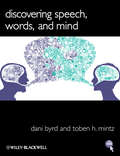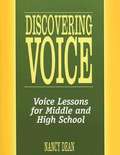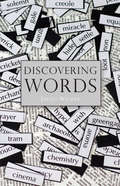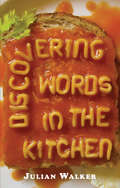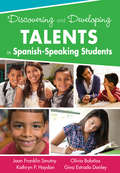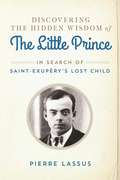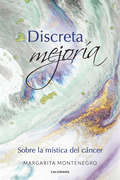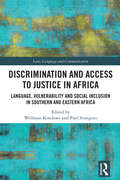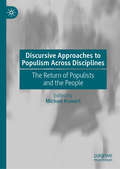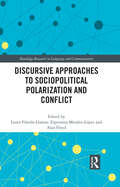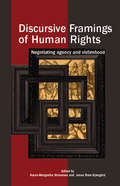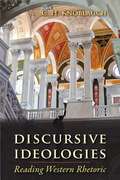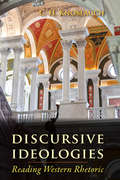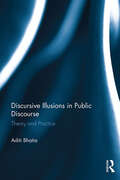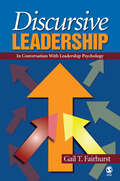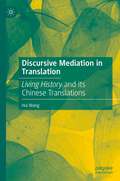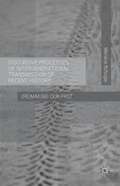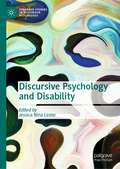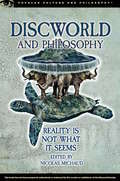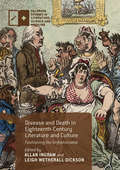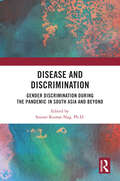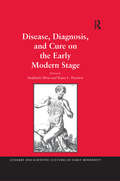- Table View
- List View
Discovering Speech, Words, and Mind
by Toben H. Mintz Dani ByrdWritten in a lively style, Discovering Speech, Words, and Mind applies a scientific approach to the study of various aspects of speech, using everyday examples to introduce the beginning student to the world of language and cognition. An accessible introduction to the fundamentals of speech production, speech perception, word-formation, language acquisition and speech disorders Considers how the informational content of the speech signal relates to phonological units – connecting the three areas of speech, words, and mind Focuses on speech production and recognition at the word-level and below, and includes sign languages Written in a highly accessible style for students with no background in linguistics or psychology Packed with numerous student-friendly features, including engaging examples, illustrations, and sidebars for further discussion; further online exercises and data also available at http://www.discoveringspeech.wiley.com/
Discovering Voice: Voice Lessons For Middle And High School
by Nancy DeanLessons on diction, detail, figurative language, imagery, syntax, and tone help middle and early high school students understand the concept of voice in what they read and develop a strong, personal voice in their own writing. Each voice lesson takes only 10-20 minutes to complete and includes a quotation selected from a wide range of literature, two discussion questions, and an exercise that encourages students to practice what they have learned about the elements of voice. Discovering Voice also offers a collection of quotations students can use to create their own voice lessons. Discussion suggestions for each voice lesson and additional activities for teaching voice further promote critical analysis.
Discovering Words
by Julian WalkerFor 1500 years English has built new words or taken them from other languages and changed their form and often their meaning to make them the words we use today. When we explore the journeys, arrivals and changes of these words, they present us with some extraordinary stories. School for example, comes indirectly from the Greek word for leisure, and lord is made from Old English words meaning keeper of bread.This book presents the histories of some common words, showing how they have arrived at their present use and form. Entries are grouped into nearly twenty subject areas, such as home, transport, food; for each word the author shows how it was built from existing words, or how a root word in another language has been taken borrowed by English at a given point in history. Some of the voyages are via many other languages, some direct; some of them are extraordinary, some deceptively simple. Changes of spelling and meaning over time are presented, and where there are disagreements about where a word has come from these are discussed. The material is presented clearly and simply, and is supported by references within the text to previous writers and dictionaries.
Discovering Words in the Kitchen
by Julian WalkerThroughout history, the English language has reflected social changes, trade routes, and waves of fashion. This book examines the histories of the names of foods, ingredients, utensils, drinks, cooking methods, and dishes to show how the vocabulary of English has reflected the ways speakers of the language have interacted with their tastes, their environment and other cultures. 250 words which have entered English over the past fifteen hundred years are examined, ranging from Old English adoptions from Latin via French, to U.S. adoptions from Chinese. Changes of spelling and meaning and disagreements about the history of the words are discussed, supported by references within the text to authoritative food historians and dictionary writers from Johnson and Webster to the most recent publications.
Discovering and Developing Talents in Spanish-Speaking Students
by Joan F. Smutny Kathryn P. Haydon Olivia G. Bolanos Gina M. Danley¡Atención! Recognize the strengths of Spanish-speaking students! How do you nurture the gifts and talents of the growing population of Hispanic students? This book provides teachers and leaders with the skills needed to uncover each child’s abilities and ultimately boost achievement for gifted Spanish-speaking students. Packed with strategies that teachers can use immediately to enhance instruction and assessment, this book shows how to: Recognize students’ unique strengths Identify and develop the gifts of bilingualism and different cultures Create challenging learning experiences for every student in the class Adapt tools and strategies to meet each learner’s unique needs Connect with parents and the greater Spanish-speaking community
Discovering the Hidden Wisdom of The Little Prince: In Search of Saint-Exupéry's Lost Child
by Pierre LassusFinally, one of the most of the most beloved books every published—explained. The Little Prince is revered around the world. Two hundred million copies have been sold in 270 languages; it is the fourth best-selling book of all time. Part of its allure is that is seems incredibly wise but so simple it is read as a work for children. Yet its meaning is elusive, and its place amid the writings of an adventurer and war hero acclaimed for dramatic bestsellers like Night Flight and Flight to Arras is mysterious. In this elegant, carefully argued book, Pierre Lassus reexamines the story of The Little Prince against the facts of Saint-Exupéry's own extraordinary life, from his cherished but fatherless childhood in aristocratic poverty to his career as a pioneering pilot. His plane had broken down in the desert before. He had adopted a fox, when posted at the Spanish fort of Cape Juby, in southern Morocco. He had known the world of business before becoming pilot; he had also known unrequited love. Like his little protagonist's, his body was never found after his plane disappeared in World War II. He was working on his spiritual autobiography when he died, and there too, Lassus finds resonances and keys to the understated spirituality of his last great book.
Discreta mejoría: Sobre la mística del cáncer
by Margarita MontenegroSapere aude, atrévete a saber. Esta es la historia de una mujer treintañera que, con un diagnóstico mortal tras el nacimiento de su primer hijo, lejos de resignarse, se dedicó en cuerpo y alma a encontrar otras vías para sobrevivir. Este libro relata sus días y noches de lectura intensa en varios idiomas, los viajes que emprendió a otros países buscando respuestas, las reuniones con todo tipo de personas, tanto ensalzadas como despreciadas en el mundo médico y científico. También revela la investigación en profundidad que realizó y los hilos de los cuales debió tirar para encontrar respuestas con enormes dificultades; y cómo, tras descubrirlas, decidió asumir un camino del que casi todo el mundo la quería disuadir. Cuenta, con una narrativa trepidante, cómo profundizó, entre otros ámbitos, en el mundo de la medicina, la psicología, la industria farmacéutica, la comunicación o la economía política del cáncer. Uncamino en el que también descubrió, para su sorpresa, que las convenciones sociales en torno a la enfermedad, la maternidad o los estereotipos sobre las mujeres, en su entorno más cercano y lejano, eran en ocasiones mayores obstáculos que su pronóstico a la hora de afrontar su día a día. Sin embargo, este libro no aspira a ser un manual de autoayuda, aunque puede servir para abrirse a nuevas realidades y avanzar. Discreta mejoría quiere ir más allá, mostrando perspectivas que no han sido nunca tratadas en relatos similares, combinando la intriga científica con una historia de supervivencia y un ejemplo de lucha contra reloj para cualquier persona que se enfrente a un reto vital.
Discretion and the Quest for Controlled Freedom
by Tony Evans Peter HupeLooking at discretion broadly as the exercise of controlled freedom, this edited volume introduces insights from a range of social sciences perspectives. Traditionally, discussions of discretion have drawn on legal notions of the appropriate exercise of legitimate authority specified by legislators. However, empirical and theoretical studies in the social sciences have extended our understanding of discretion, moving us beyond a narrow legal view. Contributors from a range of disciplines explore the idea of discretion and related notions of freedom and control across social and political practices and in different contexts. As this complex and important topic is discussed and examined, both total control and unconstrained freedom appear to be illusions.
Discrimination and Access to Justice in Africa: Language, Vulnerability and Social Inclusion in Southern and Eastern Africa (Law, Language and Communication)
by Wellman Kondowe Paul SvongoroThere are different forms of discrimination. Among others, people can be discriminated against on the basis of their ethnic grouping, political affiliation, race, gender, age, and language. This book focuses on linguistic discrimination in Africa, acknowledging that language plays a key role in the delivery of justice and much of what transpires in justice systems deals with language use. It argues that to achieve fairness, the state has a responsibility to put in place accommodations aimed at reducing linguistic vulnerability. The collection interrogates some of the issues that are common in Africa, which is arguably one of the most linguistically diverse continents in the world, bringing together a collection of case studies from Malawi, South Africa, Zimbabwe, Tanzania, Kenya, and Zambia. It presents practical insights from academics, legal professionals, and social scientists. Divided into five thematic parts, the first addresses communication and linguistic challenges faced by children in the legal system. Theme 2 examines the position of witnesses with physical challenges. The third theme focuses on language as a barrier in access to justice. Theme 4 looks at the language of the court as a major barrier to the poor and the illiterate. The fifth and final theme examines the position of women in sexual assault cases. The collection will be of interest to academics, researchers, and policymakers working in the areas of law and language, human rights law, criminology, linguistics, and African Studies.
Discursive Approaches to Populism Across Disciplines: The Return of Populists and the People
by Michael KranertThis edited book presents a cross-disciplinary and international conversation about the discursive nature of ‘populist’ politics. Based on the idea that language and meaning making are central to the political process, the authors present research originating from disciplines such as sociology, political science, linguistics, gender studies and education, giving credence to the variety and context dependence of both populist discourse and its analysis. Using a variety of different theoretical frames, the volume examines international case studies from Europe, Africa, Asia and the Americas, looking at different modes of populism as well as the interaction of populism with other ideologies and belief systems. The chapters draw on several disciplines, and will be of interest to scholars working in linguistics, political studies, journalism, rhetoric and discourse analysis.
Discursive Approaches to Sociopolitical Polarization and Conflict (Routledge Research in Language and Communication)
by Laura Filardo-LlamasThis collection explores the discursive strategies and linguistic resources underpinning conflict and polarization, taking a multidisciplinary approach to examine the ways in which conflict is constructed across a diverse range of contexts. The volume is divided into two sections as a means of identifying two different dimensions to conflict construction and bridging the gap between different perspectives through a constructivist framework. The first part comprises chapters looking at socio-political conflicts across specific geographic contexts across the US, Europe, and Latin America. The second half of the book unpacks socio-cultural conflicts, those not defined by physical borders but shaped by ideological differences on core values, such as on religion, gender, and the environment. Drawing on frameworks across such fields as linguistics, critical discourse analysis, rhetoric studies, and cognitive studies, the book offers new insights into the discursive polarization that permeates contemporary communicative interactions and the ways in which a better understanding of conflict and its origins might serve as a mechanism for providing new ways forward. This book will be of particular interest to students and scholars in critical discourse analysis, linguistics, rhetoric studies, and peace and conflict studies.
Discursive Framings of Human Rights: Negotiating Agency and Victimhood
by Karen-Margrethe Simonsen Jonas Ross KjaergardWhat does it mean to be a subject of human rights? The status of the subject is closely connected with the form and rhetoric of the framing discourse, and this book investigates the relationship between the status of the subject and the form of human rights discourse, in differing aesthetic and social contexts. Historical as well as contemporary declarations of rights have stressed both the protective and political aspects of human rights. But in concrete situations and conflictual moments, the high moral legitimacy of human rights rhetoric has often clouded the actual character of specific interventions, and so made it difficult to differentiate between the objects of humanitarian intervention and the subjects of politics. Critically re-examining this opposition – between victims and agents of human rights – through a focus on the ways in which discourses of rights are formed and circulated within and between political societies, this book elicits the fluidity of their relationship, and with it the shifting relation between human rights and humanitarianism. Analysing the symbolic framings of testimonies, disaster stories, atrocity tales, political speeches, and philosophical arguments, it thus establishes a relationship between these different genres and the political, economic, and legal dimensions of human rights discourse.
Discursive Ideologies
by C. H. KnoblauchIn Discursive Ideologies, C. H. Knoblauch argues that European rhetorical theory comprises several distinct and fundamentally opposed traditions of discourse. Writing accessibly for the upper division student, Knoblauch resists the conventional narrative of a unified Western rhetorical tradition. He identifies deep ideological and epistemological differences that exist among strands of Western thought and that are based in divergent "grounds of meaningfulness." These conflicts underlie and influence current discourse about vital public issues.Knoblauch considers six "stories" about the meaning of meaning in an attempt to answer the question, what encourages us to believe that language acts are meaningful? Six distinctive ideologies of Western rhetoric emerge: magical rhetoric, ontological rhetoric, objectivist rhetoric, expressivist rhetoric, sociological rhetoric, and deconstructive rhetoric. He explores the nature of language and the important role these rhetorics play in the discourses that matter most to people, such as religion, education, public policy, science, law, and history.
Discursive Ideologies: Reading Western Rhetoric
by C. H. KnoblauchIn Discursive Ideologies, C. H. Knoblauch argues that European rhetorical theory comprises several distinct and fundamentally opposed traditions of discourse. Writing accessibly for the upper division student, Knoblauch resists the conventional narrative of a unified Western rhetorical tradition. He identifies deep ideological and epistemological differences that exist among strands of Western thought and that are based in divergent "grounds of meaningfulness.” These conflicts underlie and influence current discourse about vital public issues. Knoblauch considers six "stories” about the meaning of meaning in an attempt to answer the question, what encourages us to believe that language acts are meaningful? Six distinctive ideologies of Western rhetoric emerge: magical rhetoric, ontological rhetoric, objectivist rhetoric, expressivist rhetoric, sociological rhetoric, and deconstructive rhetoric. He explores the nature of language and the important role these rhetorics play in the discourses that matter most to people, such as religion, education, public policy, science, law, and history.
Discursive Illusions in Public Discourse
by Aditi BhatiaThis book presents a unique perspective into the investigation and analysis of public discourses, such as those of the environment, politics, and social media, springing from issues of key relevance to contemporary society, including the War on Terror, the ‘Arab Spring’, and the climate-change debate. Employing a qualitative approach, and drawing on data which comprises both written and spoken discourses, including policy documents, political speeches, press conferences, blog entries, informational leaflets, and corporate reports, the book puts forward a unique theoretical framework, that of the Discourse of Illusion. The research draws on discourse analysis, in order to develop and implement a multi-perspective framework that allows a closer look at the intentions of the producer/actor of various discourses, power struggles within social domains, in addition to the socio-political and historical contexts which influence the individual repositories of experience that create multiple, often contesting, arguments on controversial issues, consequently giving rise to discursive illusions. Discursive Illusions in Public Discourse: Theory and practice intensively explores the discourse of illusion within multifarious dimensions of contemporary public discourses, such as: • Political Voices in Terrorism • Activist Voices in New Media • Corporate Voices in Climate Change This book will particularly appeal to researchers working within the field of discourse analysis, and more generally for students of postgraduate research and specialists in the field of language, linguistics, and media. The book can also be used as a guide for non-specialists in better understanding the complexities of public discourses, and how they shape society’s perceptions of some key social and political issues.
Discursive Leadership: In Conversation with Leadership Psychology
by Gail T Fairhurst2007 National Communication Association, Organizational Communication Division, "Best Book" AwardCiting the well known adage that there are as many definitions of leadership as there are leadership scholars, Fairhurst acknowledges the contributions which psychologists have made to leadership research, before probing the inevitable limitations to their formidable body of work. Fairhurst′s work is also thought provoking on the issue of authenticity on the part of leaders."—HUMAN RELATIONSDiscursive Leadership: In Conversation with Leadership Psychology presents a new, groundbreaking way for scholars and graduate students to examine and explore leadership. Differing from a psychological approach to leadership which tries to get inside the heads of leaders and employees, author Gail Fairhurst focuses on the social or communicative aspects between them. A discursive approach to leadership introduces a host of relatively new ideas and concepts and helps us understand leadership′s changing role in organizations. Key Features: Compares and contrasts discursive leadership with leadership psychology: This comparison facilitates a clearer definition of discursive leadership. Presents new ways to study leadership: By treating each discourse concept as a heuristic device and supporting each concept with examples, new ways to study leadership are introduced by focusing on key concepts from the organizational discourse literature. Addresses some key challenges within leadership psychology: Each chapter begins with an ongoing debate in leadership psychology and illustrates how a discursive approach can join that debate. Charimatic leadership, leader-member exchange, authentic leadership are just a few of the examples.Offers reactions from leadership psychologists: Leadership psychologists and other discourse scholars respond to the author′s proposed ′conversation′ between them broadening the debate and introducing new perspectives. Provides quick reviews and extended examples: The book includes critical summaries at the end of each chapter and easy-to-reference appendices. Intended Audience: This book helps scholars, researchers, and practitioners understand the complexities of leadership as it continues to evolve due to such influences as globalization, technology change, and democratization of the workplace. It is also an excellent text for graduate courses such as Leadership; Rhetoric of Leadership; Interpretive Studies of Organizational Communication; Organizational Communication; and Leadership & Communication in the departments of communication, business & management, psychology, and educational administration.
Discursive Mediation in Translation: Living History and its Chinese Translations
by Hui WangThis book explores the actual process of mediation operation in the translation process and the interaction between mediation and social structure. It defines mediation in translation in a parameterized manner, characterizing the linguistic properties of mediation for ease of mediation identification. On this basis, it puts forward an integrated systematic approach to map out mediation operation at the text level and discuss the interactive relationship between mediation and social structure, with a view to unveiling how the source text is altered for the purpose of power balance in the translation process. It is a key read for those interested in better understanding of how translators mediate in the translation process so as to maneuver a text to achieve a certain purpose, thereby increasing mediation efficiency and avoiding potential pitfalls in mediation operation. It will be of interest to students and scholars in translation studies, professional translators, as well as those working in language and culture, intercultural communication, and cultural studies.
Discursive Processes of Intergenerational Transmission of Recent History: (re)making Our Past
by Mariana AchugarDebates about how to remember politically contested or painful pasts exist throughout the world. As with the case of the Holocaust in Europe and Apartheid in South Africa, South American countries are struggling with the legacy of state terrorism left by the 1970s dictatorships. Coming to terms with the past entails understanding the role different social actors played in those events as well as what those event mean for us today. Young people in these situations have to learn about painful historical events over which there is no national consensus. This book explores discursive processes of intergenerational transmission of recent history through the case of the Uruguayan dictatorship. The main themes of the book are the discursive construction of social memory and intergenerational transmission of contested pasts through recontextualization, resemiotization and intertextuality.
Discursive Psychology and Disability (Palgrave Studies in Discursive Psychology)
by Jessica Nina LesterThis book explores how discursive psychology (DP) research can be applied to disability and the everyday and institutional constructions of bodymind differences. Bringing together both theoretical and empirical work, it illustrates how DP might be leveraged to make visible nuanced understandings of disability and difference writ large. The authors argue that DP can attend to how such realities are made relevant, dealt with, and negotiated within social practices in the study of disability. They contend that DP can be used to unearth the nuanced and frequently taken for granted ways in which disability is made real in both everyday and institutional talk, and can highlight the very ways in which differences are embodied in social practices – specifically at the level of talk and text. This book demonstrates that rather than simply staying at the level of theory, DP scholars can make visible the actual means by which disabilities and differences more broadly are made real, resisted, contested, and negotiated in everyday social actions. This book aims to expand conceptions of disability and to deepen the – at present, primarily theoretical – critiques of medicalization.
Discussing Bilingualism in Deaf Children: Essays in Honor of Robert Hoffmeister
by Charlotte EnnsThis collection unites expert scholars in a comprehensive survey of critical topics in bilingual deaf education. Drawing on the work of Dr. Robert Hoffmeister, chapters explore the concept that a strong first language is critical to later learning and literacy development. In thought-provoking essays, authors discuss the theoretical underpinnings of bilingual deaf education, teaching strategies for deaf students, and the unique challenges of signed language assessment. Essential for anyone looking to expand their understanding of bilingualism and deafness, this volume reflects Dr. Hoffmeister’s impact on the field while demonstrating the ultimate resilience of human language and literacy systems.
Discworld and Philosophy
by Nicolas MichaudIn Discworld, unlike our own frustrating Roundworld, everything makes sense. The world is held up by elephants standing on the back of a swimming turtle who knows where he's going, the sun goes round the world every day, so it doesn't have to be very hot, and things always happen because someone intends them to happen. Millions of fans are addicted to Pratchett's Discworld, and the interest has only intensified since Pratchett's recent death and the release of his final Discworld novel, The Shepherd's Crown, in September 2015. The philosophical riches of Discworld are inexhaustible, yet the brave explorers of Discworld and Philosophy cover a lot of ground. From discussion of Moist von Lipwig's con artistry showing the essential con of the financial system, to the examination of everyone's favorite Discworld character, the murderous luggage, to the lawless Mac Nac Feegles and what they tell us about civil government, to the character Death as he appears in several Discworld novels, Discworld and Philosophy gives us an in-depth treatment of Pratchett's magical universe. Other chapters look at the power of Discworld's witches, the moral viewpoint of the golems, how William de Worde's newspaper illuminates the issue of censorship, how fate and luck interact to shape our lives, and why the more simple and straightforward Discworld characters are so much better at seeing the truth than those with enormous intellects but little common sense.
Disease and Death in Eighteenth-Century Literature and Culture
by Allan Ingram Leigh Wetherall DicksonThis collection examines different aspects of attitudes towards disease and death in writing of the long eighteenth century. Taking three conditions as examples - ennui, sexual diseases and infectious diseases - as well as death itself, contributors explore the ways in which writing of the period placed them within a borderland between fashionability and unfashionability, relating them to current social fashions and trends. These essays also look at ways in which diseases were fashioned into bearing cultural, moral, religious and even political meaning. Works of literature are used as evidence, but also medical writings, personal correspondence and diaries. Diseases or conditions subject to scrutiny include syphilis, male impotence, plague, smallpox and consumption. Death, finally, is looked at both in terms of writers constructing meanings within death and of the fashioning of posthumous reputation.
Disease and Death in Eighteenth-Century Literature and Culture: Fashioning the Unfashionable (Palgrave Studies in Literature, Science and Medicine)
by Allan Ingram Leigh Wetherall DicksonThis collection examines different aspects of attitudes towards disease and death in writing of the long eighteenth century. Taking three conditions as examples – ennui, sexual diseases and infectious diseases – as well as death itself, contributors explore the ways in which writing of the period placed them within a borderland between fashionability and unfashionability, relating them to current social fashions and trends. These essays also look at ways in which diseases were fashioned into bearing cultural, moral, religious and even political meaning. Works of literature are used as evidence, but also medical writings, personal correspondence and diaries. Diseases or conditions subject to scrutiny include syphilis, male impotence, plague, smallpox and consumption. Death, finally, is looked at both in terms of writers constructing meanings within death and of the fashioning of posthumous reputation.
Disease and Discrimination: Gender Discrimination during the Pandemic in South Asia and Beyond
by Sourav Kumar NagThis book examines disease in the context of gender discrimination. It highlights and explores how socio-economic, political, cultural, and gender dimensions play a crucial role in understanding and defining disease.Through two broad categories – non-literary and literary – the volume discusses concerns such as media representation of gender, racial violence, domestic violence, and healthcare discrimination during Covid-19 pandemic, and focuses on the literary representation of gender discrimination related to diseases within and beyond South Asia. The chapters are based on fieldwork, demographic investigations, and statistics that offer a clear and comprehensive insight into the problems.This book will be beneficial to students and researchers of gender studies, pandemic studies, literature, anthropology, social sciences, and disease humanities.
Disease, Diagnosis, and Cure on the Early Modern Stage (Literary and Scientific Cultures of Early Modernity)
by Stephanie MossThis collection of essays makes an important contribution to scholarship by examining how the myths and practices of medical knowledge were interwoven into popular entertainment on the early modern stage. Rather than treating medicine, the theater, and literary texts separately, the contributors show how the anxieties engendered by medical socio-scientific investigations were translated from the realm of medicine to the stage by Renaissance playwrights, especially Shakespeare. As a whole, the volume reconsiders typical ways of viewing medical theory and practice while individual essays focus on gender and ethnicity, theatrical impersonation, medical counterfeit and malfeasance, and medicine as it appears in the form of various political metaphors.
